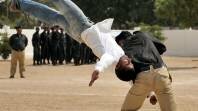Beset by political instability and infighting, Nepal is counting on the November elections to find a path to peace and prosperity
When Nepal ended a decade-long, bloody civil war in 2006, its 26 million people brimmed with optimism that the country will embark on a road to peace and prosperity. Indeed, the peace process, started under United Nations auspices in early 2007, ended the 250-year-old Hindu monarchy and ushered in a secular republic.
Having emerged from the internecine insurgency, which left 16,000 people dead, the largely Himalayan nation in 2008 held elections to Constituent Assembly, which was initially given a two-year mandate to write a new constitution for the young republic. But the legislature was dissolved in May last year after it failed to deliver the charter despite repeated extensions.
Nepal, a predominantly Hindu country sandwiched between two Asian giants India and China, has 100 caste groups and nearly as many languages and therefore is one of most heterogenous countries in South Asia. But it has been ruled by the elites representing only a handful of upper caste groups.
In order to garner support for their war, the Maoists raised the awareness of the marginalized communities including the ethnic Janajatis and low-caste Dalits. These groups, with Maoists and Madhesi parties representing the southern plains (also called Tarai) that border India as their staunch supporters, were banking on the Constituent Assembly to secure their rights.
But their hopes were shattered in May last year after the dissolution of the Constituent Assembly, which was elected as part of the peace deal signed by the former rebels and mainstream political parties in November 2006. A Supreme Court ruling of November 2011, had called the May deadline the last, forcing the politicos to seek a compromise on the fundamentals of the constitution. But it was too little and too late.
At the heart of the failure was how to restructure the country into several self-governing states in order to grant more rights to the historically disadvantaged communities.
The Maoists have proposed several federal states based on identity and ethnicity as a model that will help end the discrimination against the marginalised communities.
Opponents of such federal states-- the Nepali Congress (NC) and Unified Marxist-Leninist (UML) – have argued that it risks disintegration of the country along ethnic lines. By doing so, the two parties, however, have alienated the historically marginalised communities. The differences among the political parties still haunt as they prepare for a second chance at delivering the much-awaited constitution.
The dissolution also propelled a few new political groups, including Federal Socialist Party Nepal, headed by a senior leader of Unified Marxist-Leninist party into Nepal’s political theatre, which is crowded with over 100 political parties.
The political parties are also at loggerheads on the form of governance. The Maoists have opted for a presidential system in which executive power would be vested in a president elected directly by popular vote. Maoist chairman Pushpa Kamal Dahal, who goes by the nom de guerre Prachanda, is widely considered to be the candidate for the post.
But the NC and UML have advocated a prime minister, elected by parliament, as an executive. Maoists argue that the presidential system will provide an edge for political stability in the country, which saw four governments in as many years since the peace process began in 2006. But the opposition parties argue that such a system will lead to an authoritarian rule.
Tilak Pathak, a political reporter with Nagarik daily, Nepal’s leading Nepali-language newspaper, told Pique that the unresolved issues will certainly resurface, if not more vigourously.
“Although all the parties have pledged to own the past agreements on the nitty-gritty of constitution, as their manifestos show, they have backtracked on their promises,” Pathak said.
“This has made the task more challenging. As in the past years, the parties are likely to focus more on power sharing than on writing the constitution,” he said.
The geopolitical dynamics at play, which saw Nepal’s two neighbours keen on having fewer federal states in their backyards, according to Pathak, also contributed to the assembly’s demise. “On the one hand, India didn’t want more than two states in southern Nepal bordering its two big northern states and China was not happy with too many states bordering its restive Tibetan region, on the other,” he said.
Now with both countries lending support to the November polls, many argue that it is more certain than ever.
In March, after the squabbling political factions made it clear that they would not participate in the elections announced by a caretaker government headed by Maoist ideologue Baburam Bhattarai, Nepal’s powerful neighbor India flexed its muscle to prop up an administration led by the chief justice.
Khilraj Regmi, a tall, taciturn man, was roped in to head the interim election government from his job as chief justice of the Supreme Court. He formed an 11-person cabinet with former bureaucrats as its members, and after much delay, announced elections to be held on November 19.
Although the upcoming elections has triggered hope, assassination of a UML candidate by motorbike-riding gunmen in early October has cast an early shadow over the polls. Even before that, the government decided to deploy Nepal Army to ensure the security during the polls, first time since Nepal introduced parliamentary elections in 1990.
Mahamud Alam, a UML candidate running for a seat in a constituency in Bara district in southern Nepal, died on October 10 from gunshot wounds sustained in a shooting a week earlier. There were reports in local media claiming that the assassins had arrived in a motorbike with an Indian number plate. Some media reports tried to connect the attack with Yasin Bhatkal, a militant accused of bomb blasts in India, who was arrested in Nepal in late August and handed over to India, claiming that the slain leader had aided the militant.
Alam’s party, UML, which issued a statement saying it was outraged by the assassination and urged the government to probe it promptly, has been quick on trying to cash in on the sympathy vote: his wife, Nazma Khatun, has been fielded as a UML candidate instead of her dead husband. Three probe teams have been formed but the police have made no arrest in connection to the assassination.
Nepal shares an open and porous border with India; patron-client relations formed between the politicos and the powerful businessmen has defined politics over the years since 1990 when the popular protests ended an authoritarian regime. Like other South Asian countries, money and muscle play vital role in Nepal’s polls. These factors are likely to contribute to the rampant insecurity, fraud and trade-offs in the elections in which the country’s half of the population is eligible to cast their ballots.
A major threat to elections comes from Communist Party of Nepal-Maoist, a splinter group that broke away from the original Maoist party in June last year, which has vowed to disrupt the polls. In summer this year, the government as well as four main political parties engaged the radical faction in talks to persuade them to take part in polls. But it failed to make headway despite several attempts on the both sides.
There were conflicting reports as to what exactly caused the debacle but some of them pointed out that the original Maoist party was not keen for the radicals to vote, fearing for the diminished share in the votes because both Maoist factions count on the same downtrodden rural vote bank.
It would be downright wrong to say that Nepal hasn’t made any progress in the past five years. In late August, 70 former Maoist combatants joined the Nepal Army, their one-time adversary, bringing a formal end to the long drawn-out peace process. In December 2012, thousands of former fighters left their cantonments to start civilian lives. But the post-war peace plan, in which the drawing up of a constitution was one of two major tasks, has remained unfinished.
Although more than 100 political parties have joined in the electoral fray, the pre-election discussions have centred on which of the three major parties would emerge as the largest. In the last Constituent Assembly elections, Maoists had won nearly 40 percent of the total 601 seats.
But the detractors of the Maoists, including the political reporter Pathak, say that the former rebels, who will face a disillusioned electorate, have to accept a diminished outcome. “All three major parties will have a close call. The Maoists might do slightly better than the others and be the largest but short of a majority,” he said.
“The Maoists have lost their radical agenda because they have already been tested. They have led coalition government twice in the past five years and participated in an administration headed by a UML leader,” he said.
Political commentators believe that the fact that the CA was dissolved under the Maoist government would serve yet another blow to them. “The Bhattarai government also failed to hold polls, which is not going to help them,” Pathak said. Their constituency has further dwindled after the split in the Maoist party in June last year.
The NC, which earlier counted on the traditional, conservative forces of the deeply feudal country for a large chunk of votes, is in disarray but is likely to regain some of its lost strength in the southern plains of Tarai, its one-time stronghold. “Nepali Congress can benefit from the fragmentation in Tarai,” Pathak said.
Tarai will be a vital battleground for elections because the narrow stretch of flatland abutting India is home to half of Nepal’s population. In the last Constituent Assembly elections, the three major Madhesi parties, who represent the locals, had emerged with a significant victory.
But over the years, shifting allegiances and alliances and a penchant for power have led them to fissiparous tendencies, resulting in a nearly two dozen factions now contesting the polls.
Amid all this, there’s little enthusiasm about the elections among the hoi polloi. Hirakaji Manandhar, who runs an eatery in Kathmandu, voted for Prachanda in the last elections because he “had hopes that the battle-hardened former guerrillas held promise for a bright future.” A rotund man with an easy smile, he has now vowed not to harbour such illusions. “Before the elections, every party makes big promises.
They say ‘we will do this, we will do that.’ But they hardly implement what they promise in their manifestos,” he said. Manandhar isn’t even optimistic that the new assembly would draft the constitution. “I don’t think they will deliver it. After being elected, they will go back to fighting over who will occupy the ministries at Singhadarbar,” he said, gesturing towards the sprawling administrative headquarters which lies just across his busy eatery.
Deepak Adhikari is a journalist based in Kathmandu. He tweets @DeepakAdk
























